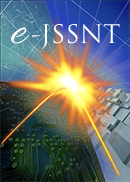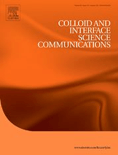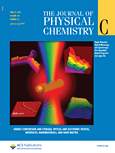
e-Journal of Surface Science and Nanotechnology
Scope & Guideline
Unlocking Innovations in Material Sciences
Introduction
Aims and Scopes
- Surface Characterization Techniques:
The journal emphasizes various surface characterization methodologies, including advanced spectroscopies (e.g., X-ray photoelectron spectroscopy, scanning tunneling microscopy) and imaging techniques to analyze material properties at the nanoscale. - Nanomaterial Synthesis and Applications:
Research on the synthesis of nanomaterials and their applications in diverse fields, such as catalysis, energy storage, and electronics, is a major focus, highlighting innovative methods and their potential impacts. - Interfacial Phenomena:
The journal covers studies on the interactions at surfaces and interfaces, exploring topics like adsorption, surface modifications, and their implications for material behavior and performance. - Theoretical and Computational Studies:
The incorporation of theoretical and computational approaches to understand and predict surface-related phenomena is a key area, often involving density functional theory (DFT) and molecular dynamics simulations. - Nanotechnology in Energy and Environmental Applications:
Research related to the application of nanotechnology in energy efficiency, renewable energy sources, and environmental remediation is increasingly featured, reflecting a commitment to sustainability.
Trending and Emerging
- Sustainable Nanotechnology:
An increasing emphasis on sustainability in nanotechnology is evident, with research focusing on green synthesis methods and environmentally friendly applications of nanomaterials. - Advanced Characterization Techniques:
There is a growing trend towards the development and application of advanced characterization techniques, especially those that provide real-time or in-situ analysis of surface phenomena. - Smart Materials and Nanocomposites:
Research on smart materials and nanocomposites that exhibit responsive behaviors to environmental stimuli is on the rise, indicating a shift towards multifunctional applications in various fields. - Electrocatalysis and Energy Applications:
The journal has seen a surge in studies related to electrocatalysis and energy applications, particularly in the context of renewable energy technologies such as fuel cells and batteries. - Machine Learning in Materials Science:
The integration of machine learning and artificial intelligence in materials science research, particularly for predicting material properties and optimizing synthesis processes, is becoming increasingly prominent.
Declining or Waning
- Traditional Bulk Material Studies:
Research focusing on bulk materials rather than surface or nanoscale phenomena appears to be decreasing, as the field shifts towards more specialized and innovative applications at the nanoscale. - Conventional Coating Techniques:
There has been a noticeable decline in studies centered around conventional coating techniques, as researchers increasingly explore novel methods and materials that leverage nanotechnology for enhanced performance. - Basic Theoretical Models without Experimental Validation:
The frequency of purely theoretical studies lacking experimental validation has waned, as the community emphasizes the importance of empirical data to support theoretical claims in surface science.
Similar Journals

Colloid and Interface Science Communications
Exploring the Frontiers of Colloid and Biotechnology ResearchColloid and Interface Science Communications is a prestigious peer-reviewed journal published by Elsevier, specializing in the vibrant fields of colloid and surface science, along with biotechnology. With an impressive open access policy initiated in 2022, this journal ensures wide dissemination of groundbreaking research. Its impact is reflected in its high standings within various Scopus category quartiles—ranked Q2 in Biotechnology and Colloid and Surface Chemistry, and Q1 in Materials Chemistry, Physical and Theoretical Chemistry, as well as Surfaces, Coatings and Films for 2023. Furthermore, it boasts exceptional Scopus rankings, including a top percentile position in several materials science categories, indicating its significant contribution to the scientific community. Published in the Netherlands, Colloid and Interface Science Communications aims to foster knowledge sharing and collaboration by providing a platform for innovators and researchers to explore cutting-edge developments in surface phenomena and materials interactions. As a key resource for researchers, professionals, and students alike, it plays a critical role in advancing our understanding and application of colloidal and interface science.

Journal of Physical Chemistry Letters
Advancing the Frontiers of ChemistryThe Journal of Physical Chemistry Letters, published by the American Chemical Society, is a premier journal in the fields of Physical and Theoretical Chemistry, Materials Science, and Nanoscience and Nanotechnology. Since its inception in 2010, this journal has established itself as a significant platform for rapid publications of cutting-edge research that bridges various branches of chemistry, providing a critical avenue for advancing knowledge in these dynamic fields. With an impressive impact factor and a consistent ranking in the top quartile (Q1) of its categories, the journal ranks 25th out of 189 in Physical and Theoretical Chemistry and 79th out of 463 in General Materials Science according to Scopus metrics. Although it currently does not operate under an open access model, it remains an essential resource for academics seeking to disseminate their findings to a global audience. Researchers, professionals, and students alike will find invaluable insights and contributions that push the boundaries of scientific inquiry within these disciplines.

Applied Surface Science Advances
Leading the Charge in Applied Surface InnovationsApplied Surface Science Advances, published by ELSEVIER, is a leading open-access journal since 2020, based in the Netherlands. With ISSN 2666-5239, this journal conducts pioneering research in the rapidly developing domains of Surfaces and Interfaces and Surfaces, Coatings, and Films. Holding a prestigious Q1 category ranking in both fields for 2023, it underscores its significance, ranking #12 out of 57 in Surfaces and Interfaces and #28 out of 132 in Materials Science according to Scopus metrics, placing it in the 79th percentile. This journal's accessible format ensures that groundbreaking studies and innovations are available to a broad audience, fostering collaboration and advancement within the scientific community. Committed to excellence, Applied Surface Science Advances not only encourages the dissemination of high-quality research but also aims to be a key resource for researchers, professionals, and students interested in the latest developments and applications in surface science.

Colloids and Interfaces
Fostering Global Collaboration in Colloidal ResearchColloids and Interfaces is a cutting-edge open access journal published by MDPI based in Switzerland, focusing on innovative research in the fields of colloid and surface chemistry. Established in 2017, this journal has quickly become a significant platform for sharing critical insights and advancements within the discipline, maintaining a commendable impact factor that reflects its scholarly importance. With a Q2 ranking in miscellaneous chemistry and a Q3 rank in colloid and surface chemistry, it stands as a vital resource for researchers and professionals dedicated to the study of colloidal phenomena. The journal's open access policy, initiated in 2018, ensures that findings are readily available to a global audience, fostering collaboration and innovation. As it continues to converge research until 2024, Colloids and Interfaces is positioned to further enhance the burgeoning field of colloidal science.

Journal of Physical Chemistry C
Pioneering innovative research in physical chemistry.The Journal of Physical Chemistry C, published by the American Chemical Society, stands as a pivotal resource in the realm of materials science and physical chemistry. With an impact factor reflecting its esteemed reputation, this journal showcases high-quality research spanning topics such as electronic, optical, and magnetic materials, as well as nanoscience and nanotechnology. Hailing from the United States, it operates without an open access model, yet its contributions are critical for advancing our understanding of surfaces, coatings, and films. Notably, the journal is classified in Quartile 1 (Q1) for several categories, underscoring its prominence in Physical and Theoretical Chemistry and related fields. Researchers, professionals, and students alike will find value in the comprehensive discussions and innovative research trends presented. The scholarly articles published from 2007 to 2024 not only drive forward scientific inquiry but also inform practical applications in various industries, making this journal an essential tool for anyone committed to excellence in the sciences.

Korean Journal of Metals and Materials
Pioneering Research for a Sustainable FutureWelcome to the Korean Journal of Metals and Materials, a premier publication dedicated to advancing research in the interdisciplinary fields of metals and materials science. Published by the Korean Institute of Metals and Materials, this journal aims to foster the dissemination of innovative findings and significant developments across various domains, including electronic, optical, and magnetic materials, metals and alloys, as well as modeling, simulation, and surface coatings. With a commendable Q3 quartile ranking in several relevant categories as of 2023, it serves as a vital resource for researchers, professionals, and students interested in the latest scientific trends and technological applications. The journal has successfully converged from 2007 to 2024, showcasing a rich archive of knowledge. Engaging with this publication gives readers the opportunity to stay updated with critical advancements and enhances collaboration within the vibrant materials science community. Access is available through various platforms, ensuring that our content is widely accessible to all those striving for excellence in the field.

Physical and Chemical Aspects of the Study of Clusters Nanostructures and Nanomaterials
Exploring the Nanoscopic World of InnovationPhysical and Chemical Aspects of the Study of Clusters, Nanostructures, and Nanomaterials is an esteemed open-access journal published by TVER STATE UNIVERSITY, dedicated to advancing the scientific discourse surrounding the intricate interplay of physical and chemical properties in nanostructure materials. Launched in 2017, this journal provides a vital platform for researchers, professionals, and students to disseminate and access cutting-edge findings in the rapidly evolving fields of nanotechnology and materials science. With an ISSN of 2226-4442 and an E-ISSN of 2658-4360, it aims to bridge the gap between academic research and practical applications. By facilitating open access to high-quality research, the journal plays an essential role in promoting innovative solutions to contemporary challenges in engineering, materials development, and related industries. The journal's scope includes but is not limited to the synthesis, characterization, and functionalization of nanomaterials, ensuring comprehensive coverage of this multidisciplinary field.

Protection of Metals and Physical Chemistry of Surfaces
Advancing Knowledge in Surface Chemistry and Metal ProtectionProtection of Metals and Physical Chemistry of Surfaces is a prominent academic journal published by MAIK NAUKA/INTERPERIODICA/SPRINGER, which provides a specialized platform for researchers and professionals in the fields of materials chemistry, metals and alloys, organic chemistry, as well as surfaces, coatings, and films. With an ISSN of 2070-2051 and an E-ISSN of 2070-206X, the journal is recognized for its rigorous peer-reviewed content and comprehensive coverage of innovative research addressing the latest advancements in material protection and surface chemistry. As of 2023, the journal has been categorized in the Q3 quartile across several relevant fields, highlighting its increasing influence within the scientific community. Although the journal is relatively niche, its open access model encourages wide dissemination of knowledge, fostering collaboration and advancements within its core disciplines. Research published in this journal plays a crucial role in not only enhancing theoretical understanding but also facilitating practical applications in various industries, thereby underlining its importance for students, researchers, and professionals alike.

Journal of Surface Investigation
Transforming Surface Studies into Tangible SolutionsThe Journal of Surface Investigation, published by PLEIADES PUBLISHING INC, is a key platform for scholars and practitioners in the fields of Nanoscience and Nanotechnology as well as Surfaces, Coatings, and Films. With an ISSN of 1027-4510 and an E-ISSN of 1819-7094, this journal serves as a repository for innovative research and comprehensive reviews, contributing significantly to the understanding and development of surface phenomena. Despite its recent Q4 ranking, it remains a crucial resource for emerging research, fostering advancements in material science. Targeting a diverse audience including researchers, professionals, and students, the journal encourages submissions that explore novel methodologies, applications, and theoretical frameworks in surface characterization and modification. It operates without an open access policy, thereby maintaining a focus on rigorous peer review and high-quality scholarly contributions. With research converging over several years, particularly from 1997-2001 and 2007-2024, the journal sustains a vital role in disseminating knowledge and stimulating innovative dialogue within the scientific community.

SURFACE AND INTERFACE ANALYSIS
Illuminating the Complexities of Material SurfacesSURFACE AND INTERFACE ANALYSIS, published by WILEY in the United Kingdom, is a renowned journal specializing in the examination of nanoscale phenomena and the properties of surfaces and interfaces across various materials. With a focus on advancing the fields of Chemistry, Condensed Matter Physics, and Materials Science, this journal has established itself as a critical resource since its inception in 1979, bridging over four decades of scientific discourse. Notably, it holds a commendable position in the Scopus rankings, emerging in the 2023 Q3 quartile across multiple categories, including Chemistry (miscellaneous) and Surfaces, Coatings, and Films. Although it does not currently offer Open Access, SURFACE AND INTERFACE ANALYSIS remains pivotal in disseminating high-quality research, providing an essential platform for academic scholars, industry professionals, and students aiming to deepen their understanding of surface phenomena and material characteristics. Its comprehensive coverage of innovative methodologies, experimental results, and theoretical insights reaffirm its significance in the scientific community.